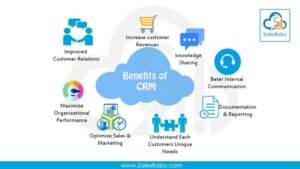Are you looking to improve your sales productivity and drive better results from your sales team? If so, then you need to invest in the right sales software stack. But with so many options available in the market, it can be challenging to choose the right one for your business. In this blog post, we will provide you with a step-by-step guide to help you choose the right sales software stack for your business.
Step 1: Identify Your Business Needs
The first step in choosing the right sales software stack is to identify your business needs. Ask yourself questions like: What are my sales goals? What sales processes do I need to streamline? Which features are essential to my business? Once you have a clear understanding of your business needs, you can start looking for sales software solutions that meet those needs.
It’s important to note that identifying your business needs is not a one-time process. As your business grows and evolves, your needs will change as well. Therefore, it’s essential to revisit this step regularly to ensure that your sales software stack continues to meet your business needs.
Step 2: Research Sales Software Solutions
Once you have identified your business needs, the next step is to research sales software solutions. There are many different types of sales software solutions available in the market, such as CRM software, sales acceleration tools, and sales intelligence software. Research each type of software solution to understand its features, benefits, and drawbacks.
When researching sales software solutions, it’s important to keep your business needs in mind. Look for software solutions that meet your business needs and have the features that are essential to your business. You can also read reviews and ratings from other users to get a better understanding of each software solution.
Step 3: Evaluate Sales Software Solutions
After researching sales software solutions, the next step is to evaluate them. Create a list of sales software solutions that meet your business needs and evaluate them based on factors such as ease of use, scalability, and cost. You can also read reviews and ratings from other users to get a better understanding of each software solution.
When evaluating sales software solutions, it’s important to keep your business needs in mind. Choose a sales software solution that meets your business needs and has the features that are essential to your business. Consider factors such as ease of use, scalability, and cost when making your decision.
Step 4: Choose the Right Sales Software Stack
Once you have evaluated different sales software solutions, the next step is to choose the right sales software stack for your business. Consider factors such as your budget, business needs, and the features offered by each software solution. Choose a sales software stack that meets your business needs and is within your budget.
When choosing the right sales software stack, it’s important to keep your business needs in mind. Choose a sales software stack that meets your business needs and has the features that are essential to your business. Consider factors such as ease of use, scalability, and cost when making your decision.
Step 5: Implement Your Sales Software Stack
After choosing the right sales software stack, the final step is to implement it. Train your sales team on how to use the software and ensure that it is integrated with your existing sales processes. Monitor the performance of your sales team and the software to ensure that it is driving the desired results.
When implementing your sales software stack, it’s important to keep your business needs in mind. Train your sales team on how to use the software and ensure that it is integrated with your existing sales processes. Monitor the performance of your sales team and the software to ensure that it is driving the desired results.
Here are some additional tips to keep in mind when choosing the right sales software stack:
- Stay up-to-date with the latest trends: The sales software market is constantly evolving, and new software solutions are being introduced all the time. Stay up-to-date with the latest trends and technologies to ensure that your sales software stack remains relevant and effective.
- Consider the user experience: The user experience is an essential factor to consider when choosing the right sales software stack. Choose software solutions that are easy to use and intuitive, and that provide a positive user experience for your sales team.
- Integrate your sales software stack with other business tools: Your sales software stack should integrate seamlessly with other business tools that you use, such as marketing automation software, customer service software, and project management software. This will help you streamline your business processes and improve your overall efficiency.
- Train your sales team: Once you have implemented your sales software stack, it’s essential to train your sales team on how to use it effectively. Provide your sales team with the necessary training and resources to ensure that they can use the software to its full potential.Monitor your sales software stack:
- Monitor your sales software stack: Monitoring your sales software stack is an essential step in ensuring that it is driving the desired results. Here are some tips to help you monitor your sales software stack effectively:
- Set clear goals: Before you start monitoring your sales software stack, it’s essential to set clear goals. Identify the key performance indicators (KPIs) that you want to track and set targets for each KPI. This will help you measure the effectiveness of your sales software stack and identify areas for improvement.
- Use analytics tools: Analytics tools can help you track your KPIs and measure the performance of your sales software stack. Use tools like Google Analytics, Mixpanel, or Kissmetrics to track your KPIs and gain insights into your sales performance.
- Monitor user adoption: User adoption is a critical factor in the success of your sales software stack. Monitor user adoption rates and identify areas where users are struggling to adopt the software. Provide additional training and support to help users overcome these challenges.
- Regularly review your sales processes: Regularly review your sales processes to ensure that they are aligned with your business needs and goals. Identify areas where your sales processes can be improved and make changes to your sales software stack accordingly.
- Stay up-to-date with the latest trends: The sales software market is constantly evolving, and new software solutions are being introduced all the time. Stay up-to-date with the latest trends and technologies to ensure that your sales software stack remains relevant and effective.
Sales Software Stack FAQ
Q: How can I choose the right sales software stack for my business?
A: Choosing the right sales software stack requires understanding your business needs and researching available solutions. Here’s a 5-step guide:
- Identify needs: What are your sales goals and processes? What features are crucial?
- Research solutions: Explore CRM, sales acceleration, and intelligence software.
- Evaluate options: Consider ease of use, scalability, and cost. Read reviews!
- Choose & implement: Select a stack that aligns with your needs and budget. Train your team and integrate with existing tools.
- Monitor & adapt: Track performance, train your team, and update your stack as your business evolves.
Q: What are the essential types of sales software?
A: The core three are:
- CRM software: Manages customer data and relationships, automating tasks and tracking interactions.
- Sales acceleration tools: Streamline lead generation, prospecting, and closing deals with features like email automation and sales intelligence.
- Sales intelligence software: Provides data and insights about potential customers, helping you target leads more effectively.
Q: What are some common mistakes to avoid when choosing a sales software stack?
A:
- Ignoring needs: Don’t get swayed by flashy features; prioritize tools that address your specific business challenges.
- Underestimating user experience: Choose software that’s intuitive and easy for your team to adopt.
- Neglecting integrations: Ensure your stack seamlessly integrates with existing business tools for optimal workflow.
- Insufficient training: Provide adequate training to empower your sales team to leverage the software’s full potential.
Q: How can I stay updated on the latest sales software trends?
A:
- Follow industry publications and blogs: Stay informed about new technologies, software updates, and best practices.
- Attend industry events and conferences: Network with other professionals and learn about the latest innovations.
- Leverage free trials and demos: Test-drive different software solutions to experience their capabilities firsthand.
Remember, choosing the right sales software stack is an ongoing process. By following these tips and staying informed, you can equip your team with the tools they need to achieve maximum sales success.




